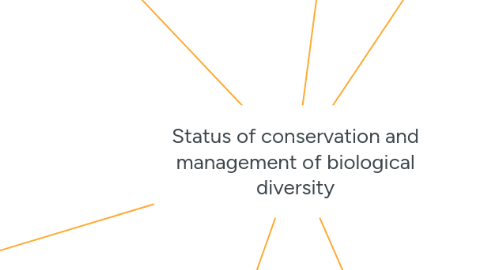
1. Ex-situ conservation
1.1. Function: To maintain species outside their original habitats in various facilities. Ease of access for scientists to study, distribute and use plant genetic resources
1.1.1. Plants
1.1.1.1. Arboretas
1.1.1.2. Seed genebanks
1.1.2. Animals
1.1.2.1. Zoos
1.1.2.2. Sanctuaries
1.1.2.3. Captive breeding centres
1.1.3. Microorganisms
1.1.3.1. Universities and research institutes' depository
1.1.4. Inadequate conservation
1.1.4.1. Urgent need for national botanical garden
2. Sectoral policies
2.1. Minimizing impacts of various economic sectors on biological diversity through incorporation of conservation of biological diversity and sustainable development into development plans
2.1.1. The Five-year Development Plans
2.1.2. The Second Outline Perspective Plan (1991-2000)
3. The legislative framework
3.1. Current: No single comprehensive legislation in Malaysia which relates to biological diversity conservation as a whole
3.1.1. Much of the legislation is sector-based (examples)
3.1.1.1. Fisheries Act 1985
3.1.1.2. Protection of Wildlife Act 1972
3.1.1.3. National Forestry Act 1984
3.2. Federal, Concurrent and State List of the Ninth Schedule
3.2.1. Legislative authority
3.2.1.1. Both Federal and State Governments
3.2.1.1.1. Protection of wild animals, wild birds and National Parks
3.2.1.2. State only
3.2.1.2.1. Forest and agriculture
3.2.1.3. Federal (apply to whole Peninsular Malaysia, Sabah and Sarawak)
3.2.1.3.1. EQA 1974
3.2.1.3.2. Fisheries Act 1985
3.2.2. Problem: Non-uniform implementation between states
4. Overview
4.1. 1970-1992: Natural forest in the whole of Malaysia was reduced by 19.3 percent
5. In-situ conservation
5.1. Function: to maintain plants and animals in their original habitat
5.2. Protected areas on land (as of 1992)
5.3. Marine waters gazetted as marine parks to (as of 1994)
5.4. Inadequate conservation efforts
5.4.1. Under-represented habitats
5.4.1.1. Wetlands
5.4.1.2. Limestone and quartz hills
5.4.2. Inadequate conservation of individual species of plants, insects or fish due to lack of adequate knowledge
5.4.3. Inadequate conservation of landraces of indigenous plant species such as fruits and rice
6. International cooperation and linkages
6.1. Ratified Convention on Biological Diversity (1994)
6.1.1. Setting commitments under the treaty by developing national policy and financial support

